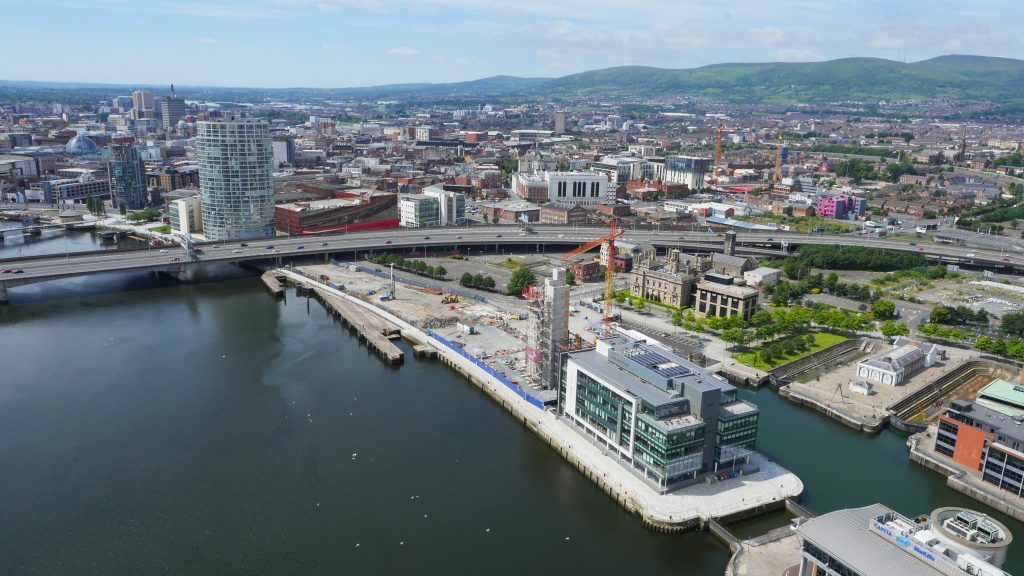Global Benchmarking Drives New Sustainable Standard
Belfast Harbour Property Executive Tim Boyle spoke to the Irish News about sustainability at City Quays.
The shortage of Grade ‘A’ office space in Belfast City Centre has been well documented, but with demand continuing to outstrip supply, even with projects such as Belfast Harbour’s £250m City Quays, more is required.
Rather than being a negative, however, Belfast should view this as an opportunity to rebuild its office stock and enhance its international real estate reputation by using high quality sustainable development as its guiding principle.
Adding a sustainable Grade ‘A’ offer to Belfast’s high-value business environment and highly skilled and motivated workforce makes Belfast the obvious location for those investors likely to add most value to our economy.

Grade ‘A’ offices are fitted out to the highest standards, usually occupy the best locations and provide stand-out versatility. The most sustainable Grade ‘A’ is even more desirable because offices such as City Quays 1 are cheaper to occupy than older office stock.
Higher rents for Grade ‘A’ also reflect their popularity with HR departments charged with securing those elusive younger, mobile workers whose work choices are shaped by their lifestyles. This is particularly the case for those knowledge-based sectors that Invest NI is keen to attract.
For these reasons Belfast Harbour has invested considerable time and resources to ensure that its developments at City Quays are in the UK’s top tier for commercial ‘green’ buildings. City Quays 1, the first office to be completed, was named Commercial Property of the Year by the Royal Institute of Chartered Surveyors, confirming its outstanding design, sustainability and flexibility.
City Quays 1 (fully let just nine months after completion) has been built to the BREEAM Excellent rating – the world’s longest established method of assessing green buildings. Securing BREEAM certification is a major endeavour which begins with the location of the development and its design process (there’s more to being sustainable than installing low energy light bulbs!).
Every aspect of City Quays 1, including the construction supply chain, has been scrutinised and assessed for environmental impact. As a result 85% of its materials were sourced from within 25 miles of the site, 97% of the waste created was diverted from landfill and much of the aggregate for the project was taken from waste produced by the new Ulster University city campus being built nearby.
Other initiatives include the extent of prefabricated design, use of heat pumps to provide heating and cooling (up to four times more efficient than traditional systems) and high performance solar control glazing to reduce solar heat gain while offering high levels of natural light. This also reduces the amount of artificial light required from the building’s 100% LED lighting system which utilises sensors to dim according to daylight levels, and to turn off completely if an area is unoccupied.
Sustainability doesn’t stop and start at the entrance foyer either – the wider 20-acre City Quays development has been master-planned to integrate with the city’s public transport network, provide additional cycle facilities and plans for a car sharing scheme. This is in addition to the existing waterfront walkway and Belfast Bike Share hub which encourage the use of more sustainable forms of transport.
Securing a BREEAM Excellent rating, however, isn’t a process that ends once the building is let. All of the high-calibre occupiers at City Quays 1 (Baker & McKenzie, Cayan, MACOM and BRS Golf) have committed to Green Leases. hese place obligations on both the landlord (Belfast Harbour) and the tenant to keep pursuing a green agenda through measures such as the creation of a Green Building Committee and commitments by occupiers to ensure that their fit-out works are energy efficient.
Safeguarding and improving the environment is an ongoing commitment and Belfast Harbour works with a wide range of stakeholders such as the Northern Ireland Environment Agency to ensure the sustainable development of the Harbour. Consequently, developments such as City Quays have helped the Harbour secure Platinum status for the seventh year in a row with Business in the Community’s ARENA environmental benchmarking survey.
With prime office rents in Belfast still below the UK average and strong local demand for more Grade ‘A’ office space, Belfast has the opportunity to position itself as a green real estate capital as it renews its office stock and incorporates the best sustainable design principles.
Methodist College Belfast, Bloomfield Collegiate School, Mitchell House School, Malone Integrated College, Aquinas Diocesan Grammar School, St Dominic’s Grammar School and St Malachy’s College took part in the challenges at Belfast Harbour, which included a presentation of their Minecraft designs and a series of Lego challenges.
How Belfast develops over the next decade will shape our skyline for much of the next century. With the prospect of falling corporation tax and the continued appeal of our workforce, the dynamic exists to carve out a niche in the international real estate market as a high quality, competitive cost destination.
Opportunities such as this come once in a generation. Looking to global best practice to ensure City Quays is future proofed makes sense for us as a business, the local economy and, of course, the environment.